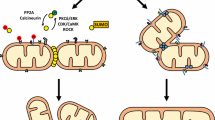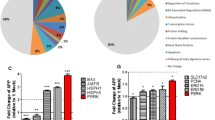Abstract
Evidence suggests that amyloid-beta (Aβ) protein is a key factor in the pathogenesis of Alzheimer’s disease (AD) and it has been recently proposed that mitochondria are involved in the biochemical pathway by which Aβ can lead to neuronal dysfunction. Here we investigated the specific effects of Aβ on mitochondrial function under physiological conditions. Mitochondrial respiratory functions and energy metabolism were analyzed in control and in human wild-type amyloid precursor protein (APP) stably transfected human neuroblastoma cells (SH-SY5Y). Mitochondrial respiratory capacity of mitochondrial electron transport chain (ETC) in vital cells was measured with a high-resolution respirometry system (Oxygraph-2k). In addition, we determined the individual activities of mitochondrial complexes I–IV that compose ETC and ATP cellular levels. While the activities of complexes I and II did not change between cell types, complex IV activity was significantly reduced in APP cells. In contrast, activity of complex III was significantly enhanced in APP cells, as compensatory response in order to balance the defect of complex IV. However, this compensatory mechanism could not prevent the strong impairment of total respiration in vital APP cells. As a result, the respiratory control ratio (state3/state4) together with ATP production decreased in the APP cells in comparison with the control cells. Chronic exposure to soluble Aβ protein may result in an impairment of energy homeostasis due to a decreased respiratory capacity of mitochondrial electron transport chain which, in turn, may accelerate neurons demise.




Similar content being viewed by others
References
Aleardi AM, Benard G, Augereau O, Malgat M, Talbot JC, Mazat JP, Letellier T, Dachary-Prigent J, Solaini GC, Rossignol R (2005) Gradual alteration of mitochondrial structure and function by beta-amyloids: importance of membrane viscosity changes, energy deprivation, reactive oxygen species production, and cytochrome c release. J Bioenerg Biomembr 37:207–225. doi:10.1007/s10863-005-6631-3
Blass JP (2003) Cerebrometabolic abnormalities in Alzheimer’s disease. Neurol Res 25:556–566. doi:10.1179/016164103101201995
Canevari L, Clark JB, Bates TE (1999) Beta-amyloid fragment 25–35 selectively decreases complex IV activity in isolated mitochondria. FEBS Lett 457:131–134. doi:10.1016/S0014-5793(99)01028-5
Cardoso SM, Proenca MT, Santos S, Santana I, Oliveira CR (2004a) Cytochrome c oxidase is decreased in Alzheimer’s disease platelets. Neurobiol Aging 25:105–110. doi:10.1016/S0197-4580(03)00033-2
Cardoso SM, Santana I, Swerdlow RH, Oliveira CR (2004b) Mitochondria dysfunction of Alzheimer’s disease cybrids enhances Abeta toxicity. J Neurochem 89:1417–1426. doi:10.1111/j.1471-4159.2004.02438.x
Casley CS, Canevari L, Land JM, Clark JB, Sharpe MA (2002a) Beta-amyloid inhibits integrated mitochondrial respiration and key enzyme activities. J Neurochem 80:91–100. doi:10.1046/j.0022-3042.2001.00681.x
Casley CS, Land JM, Sharpe MA, Clark JB, Duchen MR, Canevari L (2002b) Beta-amyloid fragment 25–35 causes mitochondrial dysfunction in primary cortical neurons. Neurobiol Dis 10:258–267. doi:10.1006/nbdi.2002.0516
Caspersen C, Wang N, Yao J, Sosunov A, Chen X, Lustbader JW, Xu HW, Stern D, McKhann G, Yan SD (2005) Mitochondrial Abeta: a potential focal point for neuronal metabolic dysfunction in Alzheimer’s disease. FASEB J 19:2040–2041
Cassarino DS, Bennett JP Jr (1999) An evaluation of the role of mitochondria in neurodegenerative diseases: mitochondrial mutations and oxidative pathology, protective nuclear responses, and cell death in neurodegeneration. Brain Res Brain Res Rev 29:1–25. doi:10.1016/S0165-0173(98)00046-0
Chagnon P, Betard C, Robitaille Y, Cholette A, Gauvreau D (1995) Distribution of brain cytochrome oxidase activity in various neurodegenerative diseases. Neuroreport 6:711–715. doi:10.1097/00001756-199503270-00002
Chang KA, Suh YH (2005) Pathophysiological roles of amyloidogenic carboxy-terminal fragments of the beta-amyloid precursor protein in Alzheimer’s disease. J Pharmacol Sci 97:461–471. doi:10.1254/jphs.CR0050014
David DC, Hauptmann S, Scherping I, Schuessel K, Keil U, Rizzu P, Ravid R, Drose S, Brandt U, Muller WE, Eckert A, Gotz J (2005) Proteomic and functional analyses reveal a mitochondrial dysfunction in P301L tau transgenic mice. J Biol Chem 280:23802–23814. doi:10.1074/jbc.M500356200
Djafarzadeh R, Kerscher S, Zwicker K, Radermacher M, Lindahl M, Schagger H, Brandt U (2000) Biophysical and structural characterization of proton-translocating NADH-dehydrogenase (complex I) from the strictly aerobic yeast Yarrowia lipolytica. Biochim Biophys Acta 1459:230–238. doi:10.1016/S0005-2728(00)00154-7
Eckert A, Keil U, Marques CA, Bonert A, Frey C, Schussel K, Muller WE (2003) Mitochondrial dysfunction, apoptotic cell death, and Alzheimer’s disease. Biochem Pharmacol 66:1627–1634. doi:10.1016/S0006-2952(03)00534-3
Eckert A, Hauptmann S, Scherping I, Meinhardt J, Rhein V, Drose S, Brandt U, Fandrich M, Muller WE, Gotz J (2008) Oligomeric and fibrillar species of beta-amyloid (Abeta42) both impair mitochondrial function in P301L tau transgenic mice. J Mol Med 86:1255–1267. doi:10.1007/s00109-008-0391-6
Fernandez-Vizarra P, Fernandez AP, Castro-Blanco S, Serrano J, Bentura ML, Martinez-Murillo R, Martinez A, Rodrigo J (2004) Intra- and extracellular Abeta and PHF in clinically evaluated cases of Alzheimer’s disease. Histol Histopathol 19:823–844
Gibson GE, Huang HM (2002) Oxidative processes in the brain and non-neuronal tissues as biomarkers of Alzheimer’s disease. Front Biosci 7:d1007–d1015. doi:10.2741/gibson
Hauptmann S, Scherping I, Drose S, Brandt U, Schulz KL, Jendrach M, Leuner K, Eckert A, Muller WE (2008) Mitochondrial dysfunction: an early event in Alzheimer pathology accumulates with age in AD transgenic mice. Neurobiol Aging. [Epub ahead of print]
Hirai K, Aliev G, Nunomura A, Fujioka H, Russell RL, Atwood CS, Johnson AB, Kress Y, Vinters HV, Tabaton M, Shimohama S, Cash AD, Siedlak SL, Harris PL, Jones PK, Petersen RB, Perry G, Smith MA (2001) Mitochondrial abnormalities in Alzheimer’s disease. J Neurosci 21:3017–3023
Jin LW, Hua DH, Shie FS, Maezawa I, Sopher B, Martin GM (2002) Novel tricyclic pyrone compounds prevent intracellular APP C99-induced cell death. J Mol Neurosci 19:57–61. doi:10.1007/s12031-002-0011-9
Keil U, Bonert A, Marques CA, Scherping I, Weyermann J, Strosznajder JB, Muller-Spahn F, Haass C, Czech C, Pradier L, Muller WE, Eckert A (2004) Amyloid beta-induced changes in nitric oxide production and mitochondrial activity lead to apoptosis. J Biol Chem 279:50310–50320. doi:10.1074/jbc.M405600200
Krahenbuhl S, Chang M, Brass EP, Hoppel CL (1991) Decreased activities of ubiquinol:ferricytochrome c oxidoreductase (complex III) and ferrocytochrome c:oxygen oxidoreductase (complex IV) in liver mitochondria from rats with hydroxycobalamin[c-lactam]-induced methylmalonic aciduria. J Biol Chem 266:20998–21003
Leuner K, Hauptmann S, Abdel-Kader R, Scherping I, Keil U, Strosznajder JB, Eckert A, Muller WE (2007) Mitochondrial dysfunction: the first domino in brain aging and Alzheimer’s disease? Antioxid Redox Signal 9:1659–1675. doi:10.1089/ars.2007.1763
Lowry OH, Rosebrough NJ, Farr AL, Randall RJ (1951) Protein measurement with the Folin phenol reagent. J Biol Chem 193:265–275
Lustbader JW, Cirilli M, Lin C, Xu HW, Takuma K, Wang N, Caspersen C, Chen X, Pollak S, Chaney M, Trinchese F, Liu S, Gunn-Moore F, Lue LF, Walker DG, Kuppusamy P, Zewier ZL, Arancio O, Stern D, Yan SS, Wu H (2004) ABAD directly links Abeta to mitochondrial toxicity in Alzheimer’s disease. Science 304:448–452. doi:10.1126/science.1091230
Mattson MP, Liu D (2002) Energetics and oxidative stress in synaptic plasticity and neurodegenerative disorders. Neuromolecular Med 2:215–231. doi:10.1385/NMM:2:2:215
Parker WD Jr, Parks J, Filley CM, Kleinschmidt-DeMasters BK (1994) Electron transport chain defects in Alzheimer’s disease brain. Neurology 44:1090–1096
Rasmussen UF, Rasmussen HN (2000) Human quadriceps muscle mitochondria: a functional characterization. Mol Cell Biochem 208:37–44. doi:10.1023/A:1007046028132
Rhein V, Eckert A (2007) Effects of Alzheimer’s amyloid-beta and tau protein on mitochondrial function—role of glucose metabolism and insulin signalling. Arch Physiol Biochem 113:131–141
Scheuermann S, Hambsch B, Hesse L, Stumm J, Schmidt C, Beher D, Bayer TA, Beyreuther K, Multhaup G (2001) Homodimerization of amyloid precursor protein and its implication in the amyloidogenic pathway of Alzheimer’s disease. J Biol Chem 276:33923–33929. doi:10.1074/jbc.M105410200
Swerdlow RH, Kish SJ (2002) Mitochondria in Alzheimer’s disease. Int Rev Neurobiol 53:341–385. doi:10.1016/S0074-7742(02)53013-0
Acknowledgments
This research was supported by grant from the SNSF (Swiss National Science Foundation) #310000-108223 to A.E.
Author information
Authors and Affiliations
Corresponding author
Rights and permissions
About this article
Cite this article
Rhein, V., Baysang, G., Rao, S. et al. Amyloid-beta Leads to Impaired Cellular Respiration, Energy Production and Mitochondrial Electron Chain Complex Activities in Human Neuroblastoma Cells. Cell Mol Neurobiol 29, 1063–1071 (2009). https://doi.org/10.1007/s10571-009-9398-y
Received:
Accepted:
Published:
Issue Date:
DOI: https://doi.org/10.1007/s10571-009-9398-y




